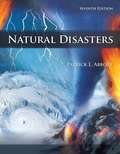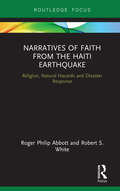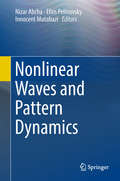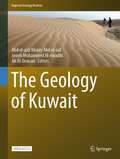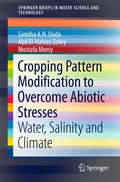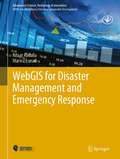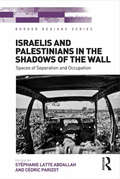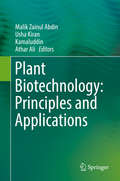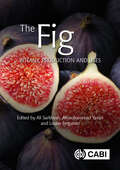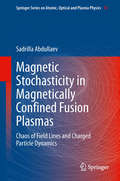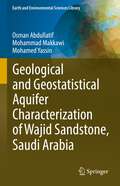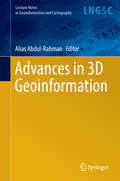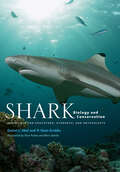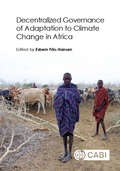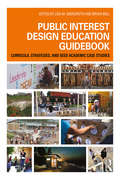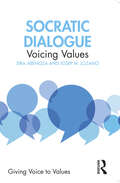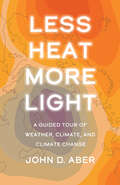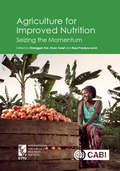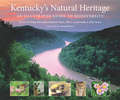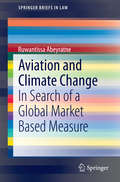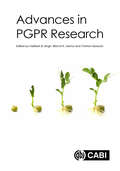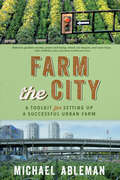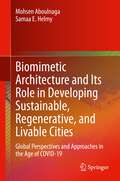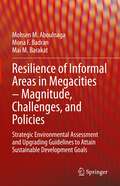- Table View
- List View
Natural Disasters (7th edition)
by Patrick Leon AbbottNatural Disasters, 7th edition, focuses on how the normal processes of the Earth concentrate their energies and deal heavy blows to humans and their structures. It is concerned with how the natural world operates and, in so doing, kills and maims humans and destroys their works. Throughout the book, certain themes are maintained: energy sources underlying disasters plate tectonics and climate change; earth processes operating in rock, water, and atmosphere; significance of geologic time; complexities of multiple variables operating simultaneously; detailed and readable case studies.
Narratives of Faith from the Haiti Earthquake: Religion, Natural Hazards and Disaster Response (Routledge Focus on Religion)
by Roger Philip Abbott Robert S. WhiteThis book presents an in-depth ethnographic case study carried out in the years following the 2010 Haiti earthquake to present the role of faith beliefs in disaster response. The earthquake is one of the most destructive on record, and the aftermath, including a cholera epidemic and ongoing humanitarian aid, has continued for years following the catastrophe. Based on dozens of interviews, this book gives primacy to survivors’ narratives. It begins by laying out the Haitian context, before presenting an account of the earthquake from survivors’ perspectives. It then explores in detail how the earthquake affected the religious, mainly Christian, faith of survivors and how religious faith influenced how they responded to, and are recovering from, the experience. The account is also informed by geoscience and the accompanying "complicating factors." Finally, the Haitian experience highlights the significant role that religious faith can play alongside other learned coping strategies in disaster response and recovery globally. This book contributes an important case study to an emerging literature in which the influence of both religion and narrative is being recognised. It will be of interest to scholars of any discipline concerned with disaster response, including practical theology, anthropology, psychology, geography, Caribbean studies and earth science. It will also provide a resource for non-governmental organisations.
Nonlinear Waves and Pattern Dynamics
by Nizar Abcha Efim Pelinovsky Innocent MutabaziThis book addresses the fascinating phenomena associated with nonlinear waves and spatio-temporal patterns. These appear almost everywhere in nature from sand bed forms to brain patterns, and yet their understanding still presents fundamental scientific challenges. The reader will learn here, in particular, about the current state-of-the art and new results in: Nonlinear water waves: resonance, solitons, focusing, Bose-Einstein condensation, as well as and their relevance for the sea environment (sea-wind interaction, sand bed forms, fiber clustering) Pattern formation in non-equilibrium media: soap films, chimera patterns in oscillating media, viscoelastic Couette-Taylor flow, flow in the wake behind a heated cylinder, other pattern formation. The editors and authors dedicate this book to the memory of Alexander Ezersky, Professor of Fluid Mechanics at the University of Caen Normandie (France) from September 2007 to July 2016. Before 2007, he had served as a Senior Scientist at the Institute of Applied Physics of the Russian Academy of Sciences in Nizhny Novgorod (Russia). The chapters have been written by leading scientists in Nonlinear Physics, and the topics chosen so as to cover all the fields to which Prof. Ezersky himself contributed, by means of experimental, theoretical and numerical approaches. The volume will appeal to advanced students and researchers studying nonlinear waves and pattern dynamics, as well as other scientists interested in their applications in various natural media.
The Geology of Kuwait (Regional Geology Reviews)
by Abd el-aziz Khairy Abd el-aal Jasem Mohammed Al-Awadhi Ali Al-DousariThis open access book contains a set of chapters covering all aspects of geosciences related to Kuwait and adjacent regions, including Iran, Saudi Arabia and the Arab Gulf states. It covers basic information about the geology including a wide range of geoscientific disciplines such as marine geology, structural geology, hydrogeology and geophysics related to the region. This book is aimed at researchers and students, as well as professionals in the field of hazard mitigation and petroleum exploration.
Cropping Pattern Modification to Overcome Abiotic Stresses: Water, Salinity and Climate (SpringerBriefs in Water Science and Technology)
by Abd El-Hafeez Zohry Samiha A. H. Ouda Mostafa MorsyThis book provides state-of-the art analysis, never done before in Egypt, on agro-climatic zones level. This study deals with how the national cropping pattern can be modified to overcome abiotic stresses, such as water scarcity, induced salinity and climate change to reduce their negative effects on food production. To this end, different cropping patterns are suggested. This study can be a framework for other developing countries to be used in quantifying and filling the gap in their knowledge about practices that can help in increasing their food security through increasing food production. Furthermore, the study is useful for policy makers to help them in their future plans and policies.
WebGIS for Disaster Management and Emergency Response (Advances in Science, Technology & Innovation)
by Rifaat Abdalla Marwa EsmailThis book aims to help students, researchers and policy makers understand the latest research and development trends in the application of WebGIS for Disaster Management and Emergency Response. It is designed as a useful tool to better assess the mechanisms for planning, response and mitigation of the impact of disaster scenarios at the local, regional or national levels. It contains details on how to use WebGIS to solve real-world problems associated with Disaster Management Scenarios for the long-term sustainability. The book broadens the reader understanding of the policy and decision-making issues related to Disaster Management response and planning.
Israelis and Palestinians in the Shadows of the Wall: Spaces of Separation and Occupation (Border Regions Series)
by Stéphanie Latte Abdallah Cédric ParizotShedding light on the recent mutations of the Israeli separation policy, whose institutional and spatial configurations are increasingly complex, this book argues that this policy has actually reinforced the interconnectedness of Israelis and Palestinian lives and their spaces. Instead of focusing on the over-mediatized separation wall, this book deals with what it hides: its shadows. Based on fieldwork studies carried out by French, Italian, Israeli, Palestinian and Swiss researchers on the many sides of the Israeli-Palestinian divide, it highlights a new geography of occupation, specific forms of interconnectedness and power relations between Israeli and Palestinian spaces. It offers a better understanding of the transformation of people’s interactions, their experiences and the ongoing economy of exchanges created by the separation regime. This heterogeneous regime increasingly involves the participation of Palestinian and international actors. Grounded in refined decryptions of territorial realities and of experiences of social actors’ daily lives this book goes beyond usual political, media and security representations and discourses on conflict to understand its contemporary stakes on the ground.
Effluent Dye Removal by Microwave-Assisted Activated Carbon (SpringerBriefs in Molecular Science)
by Rehab AbdelghaffarThis book explores the potential of advanced microwave techniques, specifically microwave-assisted pyrolysis, for the production, adsorption, and regeneration of activated carbon (AC) as a promising solution to address wastewater pollution caused by dyes. The author begins with a chapter devoted to the environmental implications of water pollution and emphasizes the characteristics of dyes and various treatment techniques for their removal. The advantages and disadvantages of commercially available activated carbon are also discussed, along with the determinants for effective adsorption using high-quality activated carbon. Additionally, the chapter delves into the different types of adsorbents, including agricultural and industrial waste, as well as bioadsorbents such as microorganisms. In Chapter 2, readers will find the latest trends in using microwave techniques for the activation process. In this chapter, the author elucidates the characteristics and mechanism of microwave heating and compares it with conventional heating methods. The advantages of microwave techniques, such as improved activation procedures and the influence of different factors, are explored. Various modeling and optimization approaches for adsorption and different techniques for analyzing the surface chemistry of activated carbons are also discussed. Furthermore, the chapter showcases the applications of microwave-assisted activated carbon for dye removal. The book closes with a chapter devoted to the recycling and regeneration of spent activated carbon (SAC) using microwave techniques. In this chapter, the author examines the procedures for SAC regeneration through microwave-assisted pyrolysis and highlights the advantages over conventional heating methods. The applications of microwave-assisted activated carbon regeneration and other miscellaneous technologies utilizing microwave heating for AC production and SAC regeneration are also explored. Given its breadth, this book is a valuable resource for researchers, professionals, and policymakers in the field of environmental science and engineering.
Plant Biotechnology: Principles and Applications
by Malik Zainul Abdin Usha Kiran Kamaluddin Athar AliThe book traces the roots of plant biotechnology from the basic sciences to current applications in the biological and agricultural sciences, industry, and medicine. Providing intriguing opportunities to manipulate plant genetic and metabolic systems, plant biotechnology has now become an exciting area of research. The book vividly describes the processes and methods used to genetically engineer plants for agricultural, environmental and industrial purposes, while also discussing related bioethical and biosafety issues. It also highlights important factors that are often overlooked by methodologies used to develop plants' tolerance against biotic and abiotic stresses and in the development of special foods, bio-chemicals, and pharmaceuticals. The topics discussed will be of considerable interest to both graduate and postgraduate students. Further, the book offers an ideal reference guide for teachers and researcher alike, bridging the gap between fundamental and advanced approaches.
The Fig: Botany, Production and Uses (Botany, Production and Uses)
by Mohammad Abdolahipour Fateh Aljane Azam Amiri Maria L Amodio Francisco C Balas Patrick Brown Zeinab Bolboli Anshul Chawla Pasqualina Colasuonno Giancarlo Colelli Neda Dalir Naser Davatgar Birgül Ertan Engin Ertan Louise Ferguson Giuseppe Ferrara Badii Gaaliche Ana I Galván A. J Galán Carlos A. Garza Jan H. Giliomee Phoebe Gordon Matthew J. Grieshop G Dalkiliç Günver Professor Jose Ignacio Hormaza Akihiro Hosomi Hidetoshi Ikegami Ali Akbar Kamgar-Haghighi Finn Kjellberg Moslem Jafari Zhihong Li Margarita López Corrales Mahshad Maghoumi Giuseppe Massimino Cocuzza Chabane Mazri Andrea Mazzeo Themis J. Michailides Reza Mostowfizadeh-Ghalamfarsa Diganta Narzary Mohamed H Neily Hitoshi Nogata Professor A Aytekin Polat Asghar Ramezanian Jean-Yves Rasplus Maria G.F. Rodrigues Sead Sabanadzovic Rajwinder K. Sandhu Manuel Joaquín Serradilla Sánchez Zeinab Shokoohi Federica Spagnoli Vassilio Stournaras Mohammad H. Tarazkar Dr Ioannis Tzanetakis Simon Van Noort Alimohammad Yavari Hiroshi Yakushiji Yue Zhang Megan Crivelli Tatjana K Kokaj Souhila Mahmoudi Ilaria MarcotuliThe common fig Ficus carica L. is an ancient fruit native to the Mediterranean. Dried figs have been successfully produced and processed in arid regions with little sophisticated infrastructure for centuries. Figs are rich in fibre, trace minerals, polyphenols and vitamins, with higher nutrient levels than most fruits. Advances in agricultural production and postharvest technologies have not only improved the efficiency of dried fig production but have facilitated the development of high value fresh fig industries both for export and domestic markets. The result is high quality fresh figs that are marketed internationally throughout the year. This book provides a comprehensive summary of fig growing, processing and marketing from a scientific and horticultural perspective. It is comprised of 19 chapters that include in-depth discussions of: History of fig cultivation; Physiology; Breeding and cultivars; Propagation; Site selection and orchard establishment; Nutrition and irrigation management; Pollination management; Integrated pest management; Greenhouse production; Harvesting, dried and fresh fig processing; The medicinal uses of figs; and World fig markets. The Fig: Botany, Production and Uses is a comprehensive applied resource for academic researchers, as well as producers, processors, and marketers of dried and fresh figs.
Magnetic Stochasticity in Magnetically Confined Fusion Plasmas
by Sadrilla AbdullaevThis is the first book to systematically consider the modern aspects of chaotic dynamics of magnetic field lines and charged particles in magnetically confined fusion plasmas. The analytical models describing the generic features of equilibrium magnetic fields and magnetic perturbations in modern fusion devices are presented. It describes mathematical and physical aspects of onset of chaos, generic properties of the structure of stochastic magnetic fields, transport of charged particles in tokamaks induced by magnetic perturbations, new aspects of particle turbulent transport, etc. The presentation is based on the classical and new unique mathematical tools of Hamiltonian dynamics, like the action--angle formalism, classical perturbation theory, canonical transformations of variables, symplectic mappings, the Poincaré-Melnikov integrals. They are extensively used for analytical studies as well as for numerical simulations of magnetic field lines, particle dynamics, their spatial structures and statistical properties. The numerous references to articles on the latest development in the area are provided. The book is intended for graduate students and researchers who interested in the modern problems of magnetic stochasticity in magnetically confined fusion plasmas. It is also useful for physicists and mathematicians interested in new methods of Hamiltonian dynamics and their applications.
Geological and Geostatistical Aquifer Characterization of Wajid Sandstone, Saudi Arabia (Earth and Environmental Sciences Library)
by Osman Abdullatif Mohammad Makkawi Mohamed YassinThe book summarizes research work on the Wajid Sandstone, which provides integrated field and laboratory data to enable a detailed description of this unit including a facies analysis, porosity data, as well as permeability data to establish aquifer models. Detailed facies analysis at outcrop scale are supported by vertical and lateral sedimentological sections, facies and environmental analysis and supplemented by detailed laboratory petrographical and petrophysical data. The analysis and interpretation of the outcrop analog models include the reconstruction of the stratigraphic architecture at outcrop scale. Moreover, the results were described statistically, analyzed and eventually establish an outcrop-based aquifer model analogue. The book benefits undergraduate, graduate and researchers working on applied sedimentological studies, hydrogeology, statistical and geostatistical analysis and modeling.
Advances in 3D Geoinformation (Lecture Notes in Geoinformation and Cartography)
by Alias Abdul-RahmanThe book presents a collection of accepted papers from the 3DGeoinfo 2015 international conference held in Kuala Lumpur, Malaysia from October 28 - 30, 2015. All papers underwent double-blind review by experts from around the globe. The conference brought together pioneering international researchers and practitioners to facilitate the dialogue on emerging topics in the field of 3D geo-information. The focus areas include: - Data Collection and Modeling: advanced approaches for 3D data collection, reconstruction and methods for representation - Data Management: topological, geometrical and network models for maintenance of 3D geoinformation - Data Analysis and Visualization: frameworks for representing 3D spatial relationships, 3D spatial analysis and algorithms for navigation, interpolation, advanced VR, AR and MR visualisation, as well as 3D visualization on mobile devices - 3D Applications: city models, Cadastre, LBS, etc.
Shark Biology and Conservation: Essentials for Educators, Students, and Enthusiasts
by Daniel C. Abel R. Dean GrubbsFeed your fascination with sharks! This complete resource enlightens readers on the biology, ecology, and behavior of sharks with approachable explanations and more than 250 stunning color illustrations.Studies of shark biology have flourished over the last several decades. An explosion of new research methods is leading to a fascinating era of oceanic discovery. Shark Biology and Conservation is an up-to-date, comprehensive overview of the diversity, evolution, ecology, behavior, physiology, anatomy, and conservation of sharks. Written in a style that is detailed but not intimidating by world-renowned shark specialists Dan Abel and Dean Grubbs, it relays numerous stories and insights from their exciting experiences in the field. While explaining scientific concepts in terms that non-specialists and students can understand, Abel and Grubbs reveal secrets that will illuminate even the experts. The text provides readers with a robust and wide range of essential knowledge as it• introduces emerging as well as traditional techniques for classifying sharks, understanding their behavior, and unraveling the mysteries of their evolution;• draws on both established shark science and the latest breakthroughs in the field, from molecular approaches to tracking technologies;• highlights the often-neglected yet fascinating subject of shark physiology, including heart function, sensory biology, digestion, metabolic performance, and reproduction;• addresses big picture ecological questions like "Which habitats do sharks prefer?" and "Where do sharks migrate and for what purpose?";• describes the astonishing diversity of sharks' adaptations to their environment;• discusses which shark conservation techniques do and don't work; and• comments on the use and misuse of science in the study of sharks.Enhanced by hundreds of original color photographs and beautifully detailed line drawings, Shark Biology and Conservation will appeal to anyone who is spellbound by this wondrous, ecologically important, and threatened group, including marine biologists, wildlife educators, students, and shark enthusiasts.
Decentralized Governance of Adaptation to Climate Change in Africa
by Charles Aben Professor Jacob Agea Bernard Bashaasha Sarah Ann D'Haen Esbern Friis-Hansen Mikkel Funder Carol Mweemba Isaac Nakendo Jonas Østergaard Nielsen Professor Imasiku Nyambe James Okiror Julie Fogt Rasmussen Godfrey SuubiTwo perspectives have dominated the social science discourse on climate change adaptation. Firstly, an international narrative among UN and donor agencies of technical and financial support for planned climate change adaptation. Secondly, a significant volume of studies discuss how local communities can undertake their own autonomous adaptation. Effective and sustainable climate adaptation requires a third focus: understanding of the political processes within sub-national institutions that mediate between national and local practices. This book address the knowledge gap that currently exists about the role of district-level institutions in Sub-Saharan Africa in providing an enabling institutional environment for rural climate change adaptation. Key Features: · Analyses the disconnect between national and local policy and practice, and how to overcome it · Analysis of the political ecology of climate change adaptation in 10 diverse rural districts across Sub-Saharan Africa based on evidence from thorough field work · Explains how to improve the efficiency and effectiveness of climate change adaptation programmes by engaging with decentralized local governments and principles of subsidiarity with regards to decision-making and control over financial resources
Public Interest Design Education Guidebook: Curricula, Strategies, and SEED Academic Case Studies (Public Interest Design Guidebooks)
by Lisa M. Abendroth Bryan BellPublic Interest Design Education Guidebook: Curricula, Strategies, and SEED Academic Case Studies presents the pedagogical framework and collective curriculum necessary to teach public interest designers. The second book in Routledge’s Public Interest Design Guidebook series, the editors and contributors feature a range of learning competencies supported by distinct teaching strategies where educational and community-originated goals unite. Written in a guidebook format that includes projects from across design disciplines, this book describes the learning deemed most critical to pursuing an inclusive, informed design practice that meets the diverse needs of both students and community partners. Featured chapter themes include Fundamental Skills, Intercultural Competencies, Engaging the Field Experience, Inclusive Iteration, and Evaluating Student Learning. The book consists of practice-based and applied learning constructs that bridge community-based research with engaged learning and design practice. SEED (Social Economic Environmental Design) academic case studies introduce teaching strategies that reinforce project-specific learning objectives where solving social, economic, and environmental issues unites the efforts of communities, student designers, and educators. This comprehensive publication also contains indices devoted to learning objectives cross-referenced from within the book as well as considerations for educational program development in public interest design. Whether you are a student of design, an educator, or a designer, the breadth of projects and teaching strategies provided here will empower you to excel in your pursuit of public interest design.
Socratic Dialogue: Voicing Values (Giving Voice to Values)
by Sira Abenoza Josep M. LozanoGiving Voice to Values is a very important tool that has helped many professionals better align what they do with what they value and believe. This book introduces the methodology of Socratic Dialogue as a complementary set of tools for creating spaces of joint reflection in which one can gain clarity about one’s values and gain the confidence to voice them effectively. Socrates’ main concern was to progressively reach a higher alignment between ideas and actions: that is, to achieve a harmony between what we think, what we say and what we do. The first step to giving voice to our values involves introspection and dialogue with others – which is how we can become aware of what we really think and value. An examined life, Socrates reminds us, is a fulfilled one. Based on the authors' more than ten years’ experience teaching Socratic Dialogue to business and law students, executives and professionals, faculty, incarcerated people and other vulnerable groups, the book provides teachers and practitioners with a roadmap to conceive, design and conduct Socratic Dialogue courses and sessions. It provides context for the method and its adaptation to the challenges of the 21st century. The book also offers guidance on how to structure a Socratic Dialogue classroom, as well as a series of tried-and-true activities and exercises, practical recommendations and testimonies of the transformative impact that dialogue courses have had on participants. The book is of prime interest to professors and educators of business ethics, as well as professional consultants working to help organizations become more responsible and introduce ethical reasoning in their decisions. It also serves as a valuable resource for social educators and practitioners in prisons and rehabilitation units, as well as teachers in primary and secondary education.
Less Heat, More Light: A Guided Tour of Weather, Climate, and Climate Change
by John D. AberA straightforward and fact-based exploration of how weather happens, how it relates to climate, and how science answers major questions about Earth as a system Climate change is one of the most hotly contested environmental topics of our day. To answer criticisms and synthesize available information, scientists have been driven to devise increasingly complex models of the climate system. This book conveys that the basics of climate and climate change have been known for decades, and that relatively simple descriptions can capture the major features of the climate system and help the general public understand what controls climate and weather, and how both might be changing. Renowned environmental scientist and educator John D. Aber distills what he has learned from a long fascination with weather and climate, the process of science, and the telling of the story of science. This is not a book about policies and politics. Instead, it explores how weather happens, how it relates to climate, and how science has been used to answer major questions about the Earth as a system and inform policies that have reversed environmental degradation. By providing a guided tour of the science of weather, this thoughtful survey will contribute clarity and rationality to the public understanding of climate change.
Agriculture for Improved Nutrition: Seizing the Momentum
by Noora-Lisa Aberman Mathew Abraham Akhter U. Ahmed Summer Allen Suresh Chandra Babu Ekin Birol Anne Bossuyt Howarth E. Bouis Kevin Chen Gerald F. Jr Olivier Ecker Dr Jessica Fanzo Aulo Gelli Julie Ghostlaw Stuart Gillespie Daniel O. Gilligan Lawrence Haddad Derek Headey Mar Maestre Hazel Malapit William Masters Ruthie Musker Nicholas Nisbett Rajul Pandya-Lorch Prabhu L Pingali Daniel J. Raiten Marie T. Ruel Amy Saltzman Zimeiyi Wang Sivan YosefAgriculture's vast potential to improve nutrition is just beginning to be tapped. New ideas, research, and initiatives developed over the past decade have created an opportunity for reimagining and redesigning agricultural and food systems for the benefit of nutrition. To support this transformation, this book reviews the latest findings, results from on-the-ground programs and interventions, and recent policy experiences from countries around the world that are bringing the agriculture and nutrition sectors closer together. Drawing on IFPRI's own work and that of the growing agriculture-nutrition community, this book strengthens the evidence base for, and expands our vision of, how agriculture can contribute to nutrition. Chapters cover an array of issues that link agriculture and nutrition, including food value chains, nutrition-sensitive programs and policies, government policies, and private sector investments. By highlighting both achievements and setbacks, Agriculture for Improved Nutrition seeks to inspire those who want to scale up successes that can transform food systems and improve the nutrition of billions of people. Key features: -Investigates the latest evidence on the relationship between agriculture and nutrition. -Includes insights from internationally renowned researchers. -Presents data from real-world settings that is highly relevant to the challenges faced by developing countries. This book is ideal for policy-makers, practitioners, and students working in agriculture, international development and nutrition.
Kentucky's Natural Heritage: An Illustrated Guide to Biodiversity
by Greg Abernathy Deborah White Ellis L. Laudermilk Marc Evans“[A] beautiful book about a state that has just about everything except a beach: mountains, swamps, rivers, plains, and, of course, the lovely bluegrass.” —Baton Rouge AdvocateKentucky’s abundance of plant and animal life, from the bottomland swamps in the west to the rich Appalachian forests in the east, is extraordinary as well as beautiful. Glades, prairies, forests, wetlands, rivers, and caves form a biologically diverse patchwork that is unique to the state. Kentucky’s Natural Heritage: An Illustrated Guide to Biodiversity provides an essential reference to the remarkable natural history of the commonwealth and is a rallying call for the conservation of this priceless legacy.Kentucky’s ecosystems teem with diverse native species, some of which are found nowhere else in the world. Kentucky’s Natural Heritage brings these sometimes elusive creatures into close view, from black-throated green warblers to lizard skin liverworts. The aquatic systems of the state are home to rainbow darters, ghost crayfish, salamander mussels, and an impressive array of other species that constitute some of the greatest levels of freshwater diversity on the planet.Richly detailed and lavishly illustrated with more than 250 color photos, maps, and charts, Kentucky’s Natural Heritage is the definitive compendium of the commonwealth’s amazing diversity and presents a persuasive argument for the necessity of conservation. Organized by a team from the Kentucky State Nature Preserves Commission, the book is an outgrowth of the agency’s focus on biodiversity protection.“Between its covers, readers will find details of Kentucky’s vanished natural areas and catalogue of the increasingly rare animal, plants and unique habitats that urgently need protection.” —Louisville Courier Journal
Aviation and Climate Change: In Search of a Global Market Based Measure (SpringerBriefs in Law)
by Ruwantissa AbeyratneThe book addresses the most critical issue faced by aviation and climate change: namely the development of a market based measure to control aircraft engine emissions. It discusses the current market economic trends as they impact to aviation and suggests steps and measures to be taken in the development of a workable MBM. ICAO has three years to come up with such an MBM on a global scale and this book will spur discussions on how to achieve this objective.
Advances in PGPR Research
by P. C. Abhilash Betina Cecilia Agaras Gautam Anand Laith K. Al-Ani Fabiola Padilla Arizmendi Fatima Berenice Salazar-Badillo Mansi Bakshi E. J. Bedmar Adrien Biessy Virendra S. Bisaria Kartikay Bisen Marieta Marin Bruzos Jesús Salvador López-Bucio Jose López-Bucio Randy Ortiz-Castro Jorge Armando Mauricio-Castillo Vasvi Chaudhry Niladri Chaudhry Manoj Kumar Chitara Pooja Choudhary Manish Kumar Dubey Pradeep Kumar Dubey Rama Kant Dubey Sheikh Adil Edirisi Martin Filion Elisabetta Franchi Deepika Goyal Natalia Cripps-Guazzone Robert Hill Antonio Castellano-Hinojosa Angela Cristina Ikeda María Fernanda Nieto-Jacobo Madhu Kamle Diwakar Kandula Dr Chetan Keswani Gagan Kumar Punam Kumari Richard Daniel Lally Robert Lawry Guillermo Nogueira-López Anupam Maharshi Shrikant S. Mantri Rafael Jorge Marcillo Dmitri V. MavrodiRhizosphere biology is approaching a century of investigations wherein growth-promoting rhizomicroorganisms (PGPR) have attracted special attention for their ability to enhance productivity, profitability and sustainability at a time when food security and rural livelihood are a key priority. Bio-inputs - either directly in the form of microbes or their by-products - are gaining tremendous momentum and harnessing the potential of agriculturally important microorganisms could help in providing low-cost and environmentally safe technologies to farmers.One approach to such biologically-based strategies is the use of naturally occurring products such as PGPR. Advances in PGPR Research explores recent developments and global issues in biopesticide research, presented via extended case studies and up-to-date coverage of: · Low input biofertilizers and biofungicides used for sustainable agriculture. · Molecular techniques to enhance efficacy of microbial inputs. · Intellectual property issues in PGPR research. Written by an international team of experts, this book considers new concepts and global issues in biopesticide research and evaluates the implications for sustainable productivity. It is an invaluable resource for researchers in applied agricultural biotechnology, microbiology and soil science, and also for industry personnel in these areas.
Farm the City: A Toolkit for Setting Up a Successful Urban Farm
by Michael Ableman“A useful manual for anyone interested in turning the concrete jungle green . . . a must-have for any urban dweller serious about farming.” —Publishers WeeklyIn Farm the City, Michael Ableman, the “Spartacus of Sustainable Food Activism,” offers a guide to setting up and running a successful urban farm, derived from the success of Sole Food Street Farms, one of the largest urban agriculture enterprises in North America. Sole Food Street Farms spans four acres of land in Vancouver, produces twenty-five tons of food annually, provides meaningful work for dozens of disadvantaged people, and has improved the surrounding community in countless ways. Coverage includes:Selecting land and choosing the right cropsGrowing food in city farms, including plans for planting and harvestingFundraising and marketing strategies, philosophies, and vital information for selling fresh productsNavigating local government and regulationsEngaging the community and building meaningful livelihoodsFarm the City is an invaluable tool kit for entrepreneurs and activists looking to create economic and social value through urban agriculture.Urban farming has the power to change diets, economies, and lives. Yet starting an urban farm can seem daunting with skills and knowledge that extend beyond growing to include marketing, sales, employees, community relations, and navigating local regulations. With this comprehensive guide, you’ll be running a successful urban farm in no time.“A story of how to bring cities back to life, literally and emotionally . . . Local food not only addresses quality of life, economy, and food security, it changes our hearts . . . [a] wonderfully written testament to life.” —Paul Hawken, New York Times-bestselling author of Drawdown
Biomimetic Architecture and Its Role in Developing Sustainable, Regenerative, and Livable Cities: Global Perspectives and Approaches in the Age of COVID-19
by Mohsen Aboulnaga Samaa E. HelmyThis book focuses on understanding biomimetic architecture and its role as a sustainable design tool. It presents the role of biomimicry in mitigation and adaptation to climate change and examines how biomimetic architecture can provide healthy solutions to limit the spread of COVID-19 in buildings and cities. Coverage includes global examples of biomimetic approaches and buildings, an evaluation of the performance of biomimicry applications in architecture to illustrate best practices, and an exploration of how nature can offer inspiration in building design to conserve resources and save energy use as well as curb carbon emissions – a reaffirmed goal of COP 26 and an outcome of Glasgow Climate Pact. Finally, the book presents guidelines to enhance urban areas and healthier spaces in buildings to meet COVID-19 social distance regulations and beyond.Examines global applications of biomimicry in architecture;Highlights the importance of biomimicry in driving livability in cities and buildings;Explores the role of biomimetic architecture in mitigating climate change.“The line of argument developed is highly relevant to the present, in addition to being original and pertinent to research on urban regeneration, especially in regard to the exploration of the use of biomimicry architecture in response to changing urban demands.” —Alessandra Battisti, Ph.D., Professor of Architecture, University of Rome La Sapienza-
Resilience of Informal Areas in Megacities – Magnitude, Challenges, and Policies: Strategic Environmental Assessment and Upgrading Guidelines to Attain Sustainable Development Goals
by Mohsen M. Aboulnaga Mona F. Badran Mai M. BarakatThis book focuses on the socio-economic and sustainability challenges facing megacities in dealing with the dramatic population increases of informal areas and settlements (or slums), especially when coupled with the impacts and risks of climate change. The authors examine informal urban areas globally and in developing countries utilizing strategic environmental assessment (SEA) as a tool to solve the sequence of upgrading steps concerning slums and shanty towns, and also establish essential guidelines for local governments and stakeholders to create a balance and quality of life for slums dwellers, particularly in the age of the COVID-19 pandemic, through applying sustainability indicators that enhance the upgrading process. Coverage includes recent statistics and mapping of informal areas worldwide and assessment of the GIZ and Sir Norman Foster models in terms of energy demands and consequential emission of CO2 and air pollution from slums. Three models of Maspero’s Triangle are also studied and assessed. The book is essential reading for a wide range of researchers, students, policymakers, governments, and professionals as well as a good source for research centers and academicians working in energy, climate change, urban environments, and sustainable urban development.
